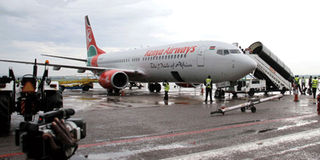African airlines to land into deeper losses in 2018

IATA attributes the losses to the failure by governments to liberalise the continent’s airspace, slow economic recovery and high operating costs. FILE PHOTO
What you need to know:
- Despite the projected growth in traffic, most of the continent’s carriers fly at 70 per cent capacity against an 80 per cent industry average.
- It adds that regional conflict and the impact of low commodity prices are other factors contributing to airlines in Africa making losses while breakeven load factors are relatively low as yields are a little higher than average and costs are lower.
Kampala. The aviation industry in Africa is projected to continue making losses this year, largely due to the failure by governments to open up skies for competition.
The International Air Transport Association (IATA) says that while globally the aviation industry is expected to make significant profits, in Africa the industry will post a cumulative loss of $100m (Shs357b), after posting a collective net loss of $100 million in 2017.
IATA attributes the losses to the failure by governments to liberalise the continent’s airspace, slow economic recovery and high operating costs.
The association which brings together the world’s airlines contends that while economic growth in Africa is expected to rebound- which will push demand for air transport to eight per cent - most airlines will continue making losses.
Despite the projected growth in traffic, most of the continent’s carriers fly at 70 per cent capacity against an 80 per cent industry average.
“Stronger economic growth will help in 2018, but governments need a concerted effort to further liberalise to promote growth of intra-Africa connectivity,” says IATA in its Industry Economic Performance 2017 report.
It adds that regional conflict and the impact of low commodity prices are other factors contributing to airlines in Africa making losses while breakeven load factors are relatively low as yields are a little higher than average and costs are lower.



